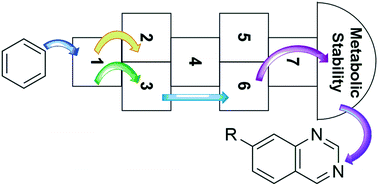当前位置:
X-MOL 学术
›
RSC Med. Chem.
›
论文详情
Our official English website, www.x-mol.net, welcomes your
feedback! (Note: you will need to create a separate account there.)
Scaffold-hopping as a strategy to address metabolic liabilities of aromatic compounds
RSC Medicinal Chemistry ( IF 4.1 ) Pub Date : 2019/12/16 , DOI: 10.1039/c9md00396g Phillip R. Lazzara 1, 2, 3, 4, 5 , Terry W. Moore 1, 2, 3, 4, 5
RSC Medicinal Chemistry ( IF 4.1 ) Pub Date : 2019/12/16 , DOI: 10.1039/c9md00396g Phillip R. Lazzara 1, 2, 3, 4, 5 , Terry W. Moore 1, 2, 3, 4, 5
Affiliation

|
Understanding and minimizing oxidative metabolism of aromatic compounds is a key hurdle in lead optimization. Metabolic processes not only clear compounds from the body, but they can also transform parent compounds into reactive metabolites. One particularly useful strategy when addressing metabolically labile or oxidation-prone structures is scaffold-hopping. Replacement of an aromatic system with a more electron-deficient ring system can often increase robustness towards cytochrome P450-mediated oxidation while conserving the structural requirements of the pharmacophore. The most common example of this substitution strategy, replacement of a phenyl ring with a pyridyl substituent, is prevalent throughout the literature; however scaffold-hopping encompasses a much wider scope of heterocycle replacement. This review will showcase recent examples where different scaffold-hopping approaches were used to reduce metabolic clearance or block the formation of reactive metabolites. Additionally, we will highlight considerations that should be made to garner the most benefit from a scaffold-hopping strategy for lead optimization.
中文翻译:

脚手架跳跃作为解决芳族化合物代谢问题的策略
了解和最小化芳族化合物的氧化代谢是优化铅的关键障碍。代谢过程不仅从体内清除化合物,而且还可以将母体化合物转化为反应性代谢产物。解决代谢不稳定或易于氧化的结构时,一种特别有用的策略是脚手架跳跃。用更缺乏电子的环系统取代芳族体系通常可以提高对细胞色素P450介导的氧化的耐受性,同时又可以保留药效基团的结构要求。在整个文献中,这种取代策略最常见的例子是用吡啶基取代基取代苯环。然而,脚手架跳跃涵盖了更广泛的杂环替代范围。这篇综述将展示最近的例子,其中使用了不同的脚手架跳跃方法来减少代谢清除率或阻止反应性代谢产物的形成。此外,我们将重点强调应考虑的因素,以从铅优化的脚手架跳槽策略中获得最大的收益。
更新日期:2020-02-13
中文翻译:

脚手架跳跃作为解决芳族化合物代谢问题的策略
了解和最小化芳族化合物的氧化代谢是优化铅的关键障碍。代谢过程不仅从体内清除化合物,而且还可以将母体化合物转化为反应性代谢产物。解决代谢不稳定或易于氧化的结构时,一种特别有用的策略是脚手架跳跃。用更缺乏电子的环系统取代芳族体系通常可以提高对细胞色素P450介导的氧化的耐受性,同时又可以保留药效基团的结构要求。在整个文献中,这种取代策略最常见的例子是用吡啶基取代基取代苯环。然而,脚手架跳跃涵盖了更广泛的杂环替代范围。这篇综述将展示最近的例子,其中使用了不同的脚手架跳跃方法来减少代谢清除率或阻止反应性代谢产物的形成。此外,我们将重点强调应考虑的因素,以从铅优化的脚手架跳槽策略中获得最大的收益。











































 京公网安备 11010802027423号
京公网安备 11010802027423号